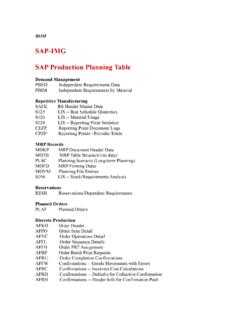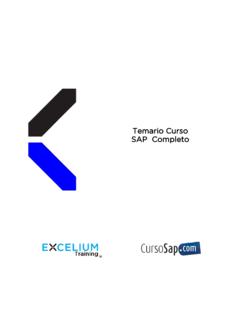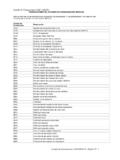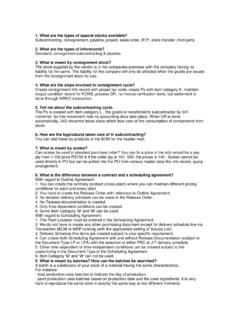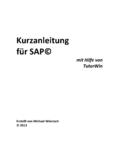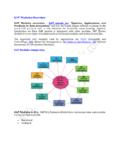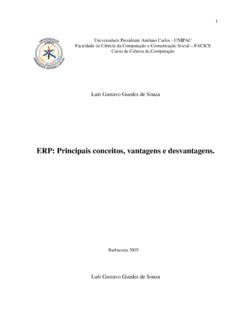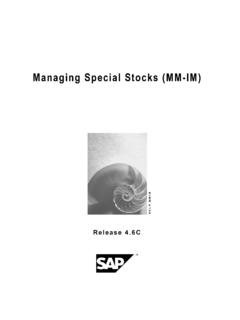Transcription of Implementation of System Application Product …
1 International Journal of Scientific and Research Publications, Volume 2, Issue 9, September 2012 1 ISSN 2250-3153 Implementation of System Application Product (SAP) Materials Management (MM-Module) for Material requirement planning (MRP) in Sugar Industry S. Chandraju*1; B. Raviprasad1; C. S. Chidan Kumar2 1 Department of Studies in Sugar Technology,Sir M. Vishweshwaraya Post graduate Center, University of Mysore, Tubinskere - 571402,Mandya, Karnataka, India. 2 Department of Chemistry, Alva s Institute of Engineering & Technology, Shobhavana Campus, Mijar, Moodbidri - 574225, South Canara , India Abstract- SAP has been delivering on its Sugar industry strategy by expanding its capabilities for manufacturing and supply chain management, broadening its composite package applications in areas such as emissions management, pricing management, and manufacturing dashboards, and focusing on mid-market companies.
2 To implement an integrated System of production planning and materials management, there must have a central database wherein anyone in the company can find out all there is to know about any material passing through the plant. Everyone must use the same rules and data structures when they enter data about material details. The integration of all material data in a single database object eliminates redundant data storage. Areas such as purchasing, inventory management, material requirements planning (MRP), invoice verification, and so on, can all use the same data. By implementing SAP (MM-Module) in sugar industry for Material requirement planning, the Product can be ordered and received within safety period. Based on material group classified under ABC analysis.
3 Planning can also be done on priority by calling vendors for particular commodities through online. Index Terms- Materials Management, Material requirement Planning, System Application Product , Bill of Product , Just in time I. INTRODUCTION RP is simply materials management of input items to the production process where demand is relatively even over time. MRP comes in many forms but is primarily a computer-based integrated System with varying degrees of complexity and best example of a materials requirement planning System is the human brain, or any other brain for that matter, not only does it provide the action link to `the knee bone is connected to the thigh bone, etc', it brings in the blood and nutrients to produce the final Product of movement, intention and communication.
4 " The Implementation of MRP in sugar industry help them to plan and discuss about Materials requirements planning, referred to by the initials MRP, is a technique which assists a Sugar industry in the detailed planning of its production. MRP translates that aggregate plan into an extremely detailed plan Requirement of production and how many production units required, Lead time requirements. Level of Inventory at beginning of the planning horizon. Scheduled receipts of inventory during period. Other information s such as supplier names & addresses, lead-times and purchase quantities. II. MATERIALS AND METHODS Material requirements planning (MRP) is a computer-based inventory management System designed to assist production managers in scheduling and placing orders for dependent demand items.
5 Dependent demand items are components of finished good such as raw materials, component parts, and subassemblies or which the amount of inventory needed depends on the level of production of the final Product . MRP systems offer a number of potential benefits to Sugar manufacturing firms. Some of the main benefits include helping production managers to minimize inventory levels and the associated carrying costs, track material requirements, determine the most economical lot sizes for orders, compute quantities needed as safety stock, allocate production time among various products, and plan for future capacity needs. The information generated by MRP systems is useful in other areas as well. "A range of people in a typical manufacturing company are important users of the information provided by an MRP System .
6 Evolution of MRP - Material Requirement Planning - The concept of Material Requirement planning (MRP I) was designed as a tool to help planners with the derivation of the quantities of various material or components that would be required for satisfying a demand and at the same time for deriving the capacity based plan for loading the orders for production on the shop floor. The concept which started as a less integrated mainframe tool has evolved over the years since 1960, from the time it was first designed, to now, where it is tagged as Material Resource Planning (MRP II), a much stronger integrated version of the first MRP, integrating it with the finance, human resource, purchasing and production modules of a business. It also had much stronger and complex codes to take care of a few constraints in capacity and material planning.
7 The MRP II jargon later took on to be called as ERP or Enterprise resource planning with the greatest possible M International Journal of Scientific and Research Publications, Volume 2, Issue 9, September 2012 2 ISSN 2250-3153 integration with a central database server, storing all the integrated data there for making the information and data available across the business, across business modules and across its vendors/suppliers and customers. With the evolution of ERP (a superior clone of the evolved MRP II) businesses took it as the most wildest tool that they could have to make their business run smoothly, in a much integrated fashion without loosing any information or spoiling the intension of the information when it flows across the business.
8 SAP came across as the very first few companies which evolved the concept of MRP II in to ERP and earning for themselves a growing business by selling this new concept. Companies and businesses across the world made use of this ERP tool and the standard processes offered to profit themselves. MRP in context with production management processes Fig chart of production Management Overall View of the Inputs to a Standard Material Requirements Program and the Reports Generated by the Program Fig 2. Process of generating reports International Journal of Scientific and Research Publications, Volume 2, Issue 9, September 2012 3 ISSN 2250-3153 III. DESCRIPTION Material Requirements Planning is a time phased priority-planning technique that calculates material requirements and schedules supply to meet demand across all products and parts in one or more plants.
9 Information Technology plays a major role in designing and implementing Material Requirements Planning systems and processes as it provides information about manufacturing needs (linked with customer demand) as well as information about inventory levels. MRP techniques focus on optimizing inventory. MRP techniques are used to explode bills of material, to calculate net material requirements and plan future production. Object of Material Requirements Planning - The globalization of the economy and the liberalization of the trade markets have formulated new conditions in the market place which are characterized by instability and intensive competition in the business environment. Competition is continuously increasing with respect to price, quality and selection, service and promptness of delivery.
10 Removal of barriers, international cooperation, technological innovations cause competition to intensify. In terms of manufacturing emphasis is placed on reducing cost while improving quality. In addition, other factors such as timely delivery of the Product become critical (this is captured by emphasis in Just in Time or JIT in short) techniques. MRP systems use four pieces of information to determine what material should be ordered and when. The master production schedule, which describes when each Product is scheduled to be manufactured; Bill of materials, which lists exactly the parts or materials required to make each Product ; Production cycle times and material needs at each stage of the production cycle time; and, Supplier lead times. The master schedule and bill of materials indicate what materials should be ordered; the master schedule, production cycle times and supplier lead times then jointly determine when orders should be placed The Master Production Schedule includes quantities of products to be produced at a given time period.










